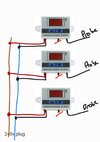Hi all. Probably quite a simple question.
I have 3 temperature controllers with thermometers. I don't want to use the controllers, just the thermometer).
They are all 240v
I have mounted them to a board and want to have one 240v cable on a socket to run them in parallel.
Question 1: what is the best way to use the cable without cutting it to connect these up to?
Question 2: can you solder 240v devices onto a cable as opposed to using a connector of sorts.
Thanks
I have 3 temperature controllers with thermometers. I don't want to use the controllers, just the thermometer).
They are all 240v
I have mounted them to a board and want to have one 240v cable on a socket to run them in parallel.
Question 1: what is the best way to use the cable without cutting it to connect these up to?
Question 2: can you solder 240v devices onto a cable as opposed to using a connector of sorts.
Thanks


